In the USDA National Agricultural Statistics Service (NASS) semiannual Cattle report released on Jan. 31, the total number of cattle and calves on Jan. 1, 2022, was estimated at 91.902 million head – 2%, or nearly 1.888 million head lower than the previous year.In 2019, the cattle and calves inventory was 94.805 million head, but over the last three years, it has declined to its present level.
Most of the decline can be attributed to fewer cows and heifers having calved, down by 2% or 786,000 head, especially beef cows, which were 719,000 head – or 2.3% – lower than a year ago. States with the largest reductions in beef cows included South Dakota (-189,000), Texas (-160,000), Missouri (-94,000) and Montana (-90,000 head). Poor pasture and range conditions were the primary causes of this contraction in the West and Plains regions. Hay stocks on Dec. 1, 2021, were also down 6% from a year ago, and tight supplies in parts of the country may have influenced producers’ ability to maintain cow herds.
Compared to last year, beef cattle producers are indicating their intentions to retain 3% less heifers for beef cow replacement, with the largest reductions in Texas (-110,000 head) and Montana (-50,000 head). The number of heifers expected to calve during the year is also down 3%. The lower number of heifers retained implies that the national herd is unlikely to expand. A similar pattern is reflected on the dairy side, with milk cow numbers down 1% and heifers for milk cow replacement down 3%.
The calf crop for 2021 was estimated at 35.085 million head, or about 410,100 head lower than 2020. The total number of cattle on feed was estimated at 14.7 million head on Jan. 1, 2022, relatively unchanged from 2021. The lower 2021 calf crop and relatively stable cattle on feed numbers contributed toward fewer cattle outside feedlots at the beginning of the year, which totaled 25.5 million head or 3% below Jan. 1, 2021, indicating supplies of cattle for placement during the year are likely to be constrained.
Beef production up fractionally in 2022
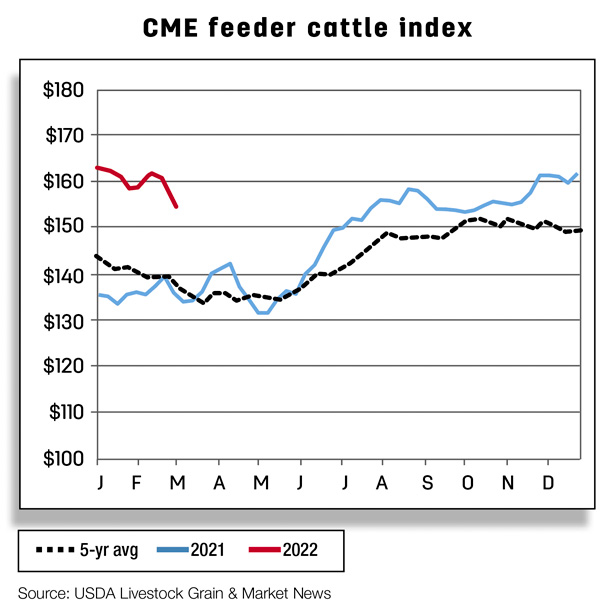
The 2022 annual forecast for commercial beef production was raised by 210 million pounds to 27.375 billion pounds from the previous month due to expected strong fed cattle slaughter and heavier average dressed weights. More feeder cattle entered the feedlots than initially expected late in the fourth quarter, and placements in the first part of 2021 are expected to reflect tight forage supplies and conditions in winter pasture areas. This will lead to higher fed cattle marketings and slaughter during 2022. While fed cattle slaughter is expected to rise in the second half, cow slaughter is forecast slightly lower due to fewer cows being available for slaughter and expectations producers will retain cows to rebuild their herds in the face of improved returns and favorable pasture and forage conditions. Average carcass weights are raised in second-half 2022, reflecting a large number of fed cattle and fewer non-fed cattle slaughtered in the second half of 2022.
Fed and feeder steer prices
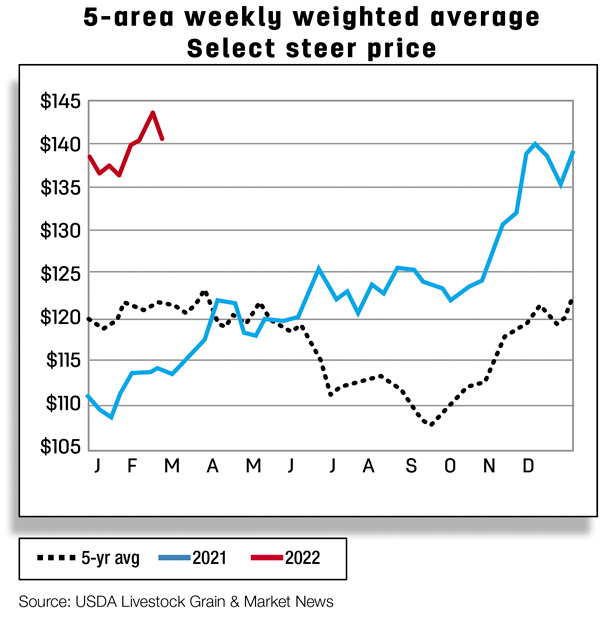
In January 2022, the average price for all grades of live steers sold in the 5-area marketing region was reported at $137.27 per hundredweight (cwt), up 24%, or $26.62, from January 2021. The fed steer price for the week ending Feb. 6 was $139.76 per cwt, up 23%, or $26.13, from a year earlier. The first-half forecast for the fed steer price was left unchanged. However, the third-quarter forecast was raised $1 to $135, while the fourth-quarter forecast was revised up $2 to $140 per cwt. The 2022 annual price forecast for fed steers was increased by 75 cents to $137.50 per cwt from the previous month on expected strength in packer demand.
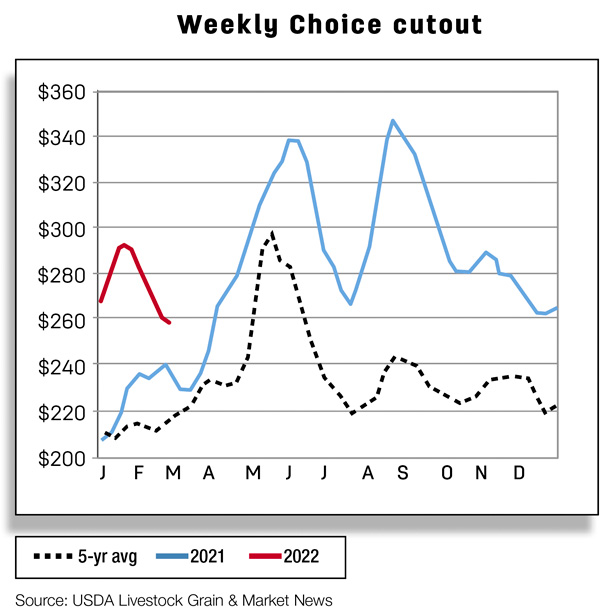
Prices at the Oklahoma City National Stockyards for feeder steers sold in January weighing 750 to 800 pounds had an average price of $157.78 per cwt, up 17.8%, or $23.84 per cwt from a year ago. Feeder prices averaged $160.46 per cwt for Feb. 6, up $29.40 above the price recorded the same week a year ago. The first-quarter forecast was lowered by $1 to $158 per cwt from the previous month. The feeder steer 2022 forecasts for the second, third and fourth quarters were all raised by $2 to $158, $162 and $167 per cwt, respectively. The annual forecast for the feeder steer price was increased by $1.25 to $161.25 per cwt from the previous month in support of expected demand for a tighter supply of calves.
2021 beef exports conclude on a record note
In December, U.S. beef exports set a record for the month at 288 million pounds, about 1% above a year earlier and more than 9% above the five-year average. With the aid of larger year-over-year shipments to other markets, exports to China, South Korea, Canada and Taiwan more than offset reduced purchases from Mexico, Hong Kong, Japan and Vietnam. For 2021, exports tallied a record 3.447 billion pounds, up almost 17% from a year ago and about 18% above the 2016-20 average.
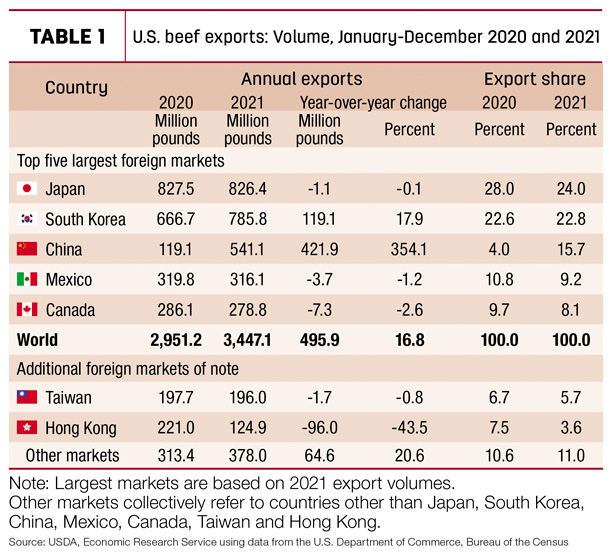
U.S. beef sales to Japan were 6% lower in December than in 2020, bringing 2021 shipments just shy of 2020 levels. As shown in the table, Japan was responsible for less of the export share than in 2020 but remained the top destination at 826 million pounds. Shipments to South Korea, the No. 2 destination, set a record for the month of December at 58 million pounds, a rise of 17 percent from 2020. Total 2021 beef sales to South Korea set a record at 786 million pounds, and it was one of two major destinations with an expansion in the share of U.S. beef exports over 2020.
The third-largest destination, China, bought almost 50 million pounds in December, for a total of 541 million pounds in 2021. Driven by China’s demand for animal protein, U.S. beef exports to China in 2021 topped 541 million pounds, equal to nearly 91% of the volume of U.S. beef exports to North America. Although U.S. beef exports to China made significant gains in 2021, based on China’s import data, the U.S. was just the sixth-largest supplier to China with only 6% of market share.
U.S. exports to Canada and Mexico consisted of shipments in December up 19% and down 44%, respectively, from a year ago. In aggregate, both destinations purchased slightly less beef from the U.S. in 2021 than in 2020.
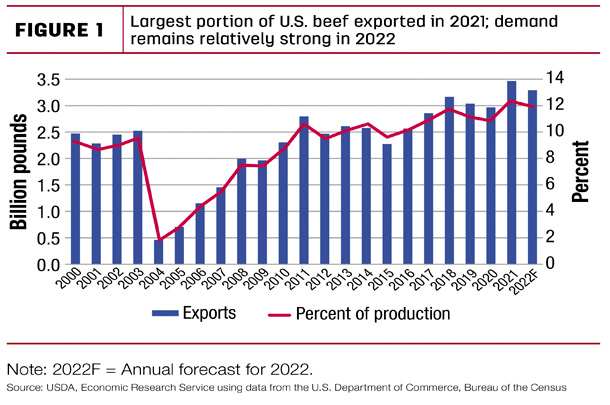
A number of other markets, beyond the seven countries listed in the table, collectively consumed a greater share of U.S. beef in 2021, up 21%, or 65 million pounds, from 2020 and 9% above the five-year average. Member countries of the Dominican Republic-Central America Free Trade Agreement collectively purchased 64% more U.S. beef than in 2020 and 48% above the five-year average. In addition, 2021 exports to Indonesia and the Philippines had a gain of 32% and 9%, respectively, from 2020.
Exports were greater than those expected at the start of 2021, with global demand pulling a record portion from U.S. domestic production despite historically elevated beef prices. As the figure shows, exports as a share of production reached more than 12%. This suggests that global beef demand recovered quite well in 2021. Although demand is expected to remain relatively strong in 2022, U.S. beef exports are forecast to decline 5% to 3.27 billion pounds because of greater expected exportable supplies from Oceania and South America. Further, U.S. exports are expected to pull almost 12% from production in 2022, second only to 2021.
2022 import forecast raised
Beef imports totaled 273 million pounds in December, up 30% year-over-year. Imports from Mexico and Brazil set record highs for the month. Imports from Mexico were 56 million pounds, a year-over-year increase of 63%. Imports from Brazil were up 160% year-over-year at 51 million pounds. Other notable increases came from Argentina, with a year-over-year increase of over 7 million pounds, and Canada, up 11% year-over-year at 64 million pounds. December imports from Australia were down 19% compared to 2020.
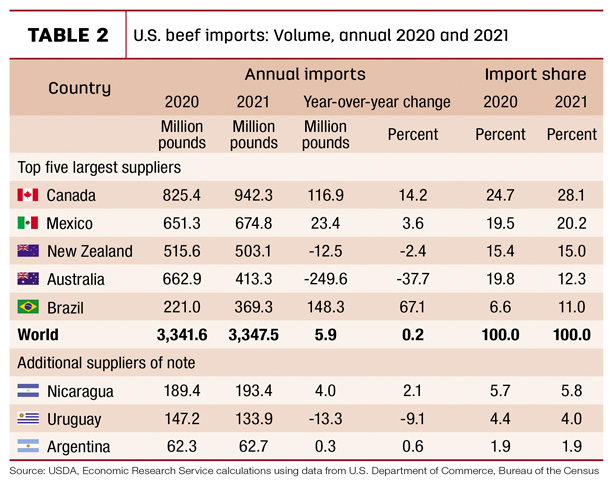
Fourth-quarter 2021 imports totaled 863 million pounds, 25% higher year-over-year. This was the second-highest fourth-quarter import level, behind 2004. While cumulative imports lagged behind the previous year for most of 2021, strong fourth-quarter imports led to an annual year-over-year increase of just under 6 million pounds.
Import levels for the first half of 2021 fell below 2020 and the five-year average, partly due to declines in imports from Australia. Australia was historically one of the top two suppliers of beef imports to the U.S., but recent drought caused a contraction in inventories. Throughout 2021, the country showed signs of herd rebuilding as they retained more animals for breeding, resulting in limited exportable supplies.
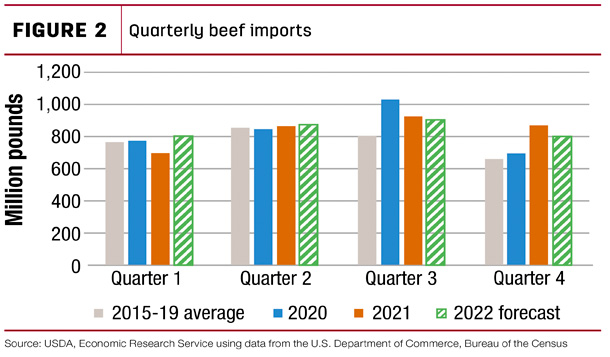
Imports in the second half of 2021 began to pick up, especially from Canada, Mexico and Brazil. Fourth-quarter imports from Mexico and Brazil were record highs for the quarter. Imports from Mexico increased by 59% year-over-year, while imports from Brazil increased nearly 78%. A U.S. ban on fresh imports from Brazil was lifted in 2020, and the rapid import growth continued throughout 2021.
By the end of the year, increases in imports from Canada, Mexico, Brazil and other smaller traders more than offset the decrease from Australia. Total beef imports for 2021 were 3.35 billion pounds, a slight increase from the previous year. This was the largest annual import level since 2015. Mexico, Brazil and Nicaragua set annual records at 647, 369 and 193 million pounds, respectively.
Canada remained the largest supplier of beef imports for the fifth year in a row, accounting for 28% of annual imports. Total imports from Canada increased 14% year-over-year. Mexico was the second-largest supplier of beef imports to the U.S., with a 20% share. Imports from New Zealand, the third-largest supplier, were down 2% compared to 2020 but accounted for a share of 15%, relatively unchanged from the previous year.
Annual imports from Australia were down 38% year-over-year, accounting for only 12% of the total imports but making Australia the fourth-largest source of beef imports. Total annual imports from Brazil increased by 67% year-over-year, raising the share of imports from Brazil to 11% in 2021.
Based on sustained strong domestic demand, the annual forecast for 2022 beef imports was increased by 105 million pounds to 3.37 billion pounds, a year-over-year decrease of less than 1%. The first-quarter import forecast was raised 50 million pounds on increased supplies from Latin America. Increased availability of exportable supplies from Oceania will support continued strong imports in the latter half of 2022.






